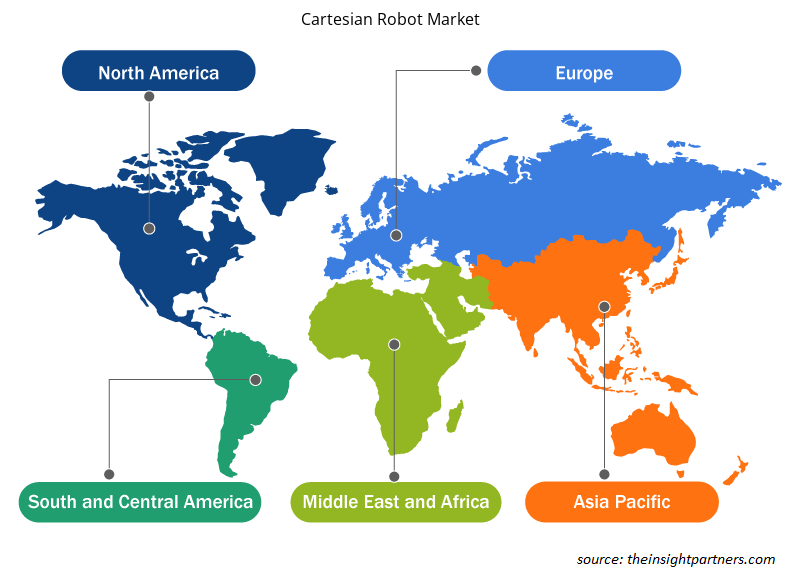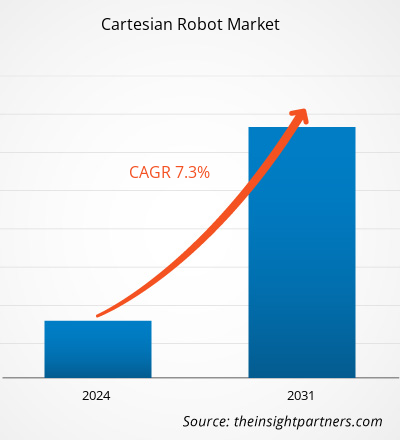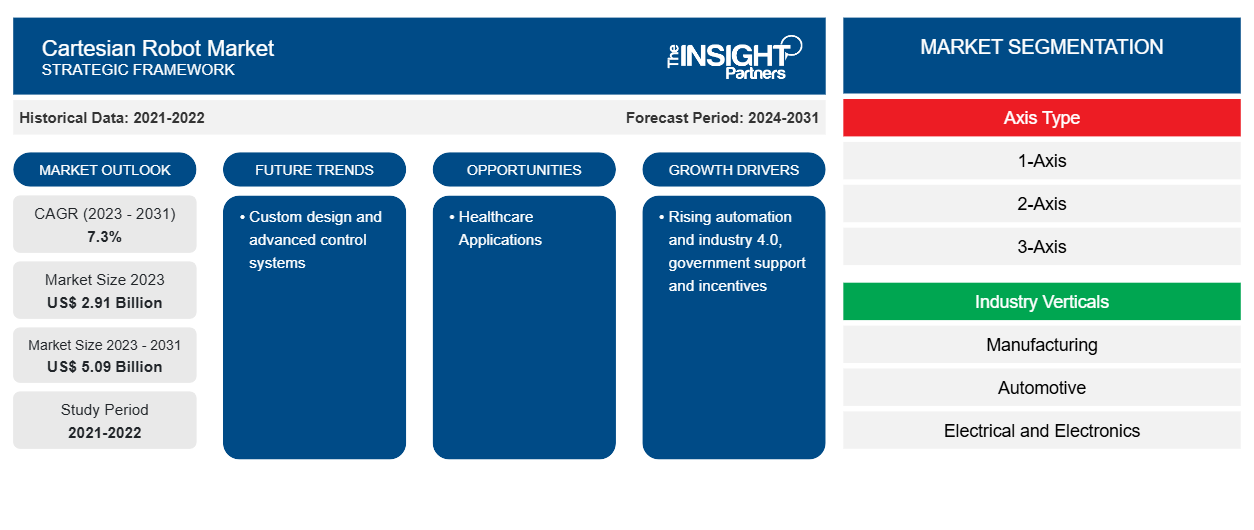Der Markt für kartesische Roboter soll von 2,91 Milliarden US-Dollar im Jahr 2023 auf 5,09 Milliarden US-Dollar im Jahr 2031 anwachsen. Der Markt soll zwischen 2023 und 2031 eine durchschnittliche jährliche Wachstumsrate (CAGR) von 7,3 % verzeichnen. Kundenspezifisches Design und fortschrittliche Steuerungssysteme bleiben voraussichtlich weiterhin die wichtigsten Trends auf dem Markt für kartesische Roboter.
Kartesische Roboter Marktanalyse
Kartesische Roboter, Linearroboter und Portalroboter sind allesamt Begriffe für mechatronische Roboter, die sich entlang linearer Achsen bewegen. Portalroboter ähneln Portalkränen und verhalten sich ähnlich. Portalroboter können jedoch mehr als nur heben und bewegen. Sie können je nach Anforderungen über spezifische Funktionen verfügen.
Marktübersicht für kartesische Roboter
Kartesische Roboter sind eine beliebte und einfache Robotertechnologie , die Hersteller seit Jahrzehnten nutzen. Unternehmen aller Branchen und Anwendungsbereiche profitieren von den Vorteilen dieser skalierbaren Technologie. Kartesische Roboter sind die vielseitigsten verfügbaren Roboterplattformen. Diese Skalierung erstreckt sich sowohl auf ihre potenzielle physische Größe als auch auf ihre maximale Stärke. Kartesische Roboter können so klein wie Mini-3D-Drucker oder so groß wie gewünscht sein. Mittlerweile sind viele riesige kartesische Roboter erhältlich, die 50 Meter (164 Fuß) oder länger sind. Das liegt an der Mechanik. Zahnstangen- und Ritzelantriebe ermöglichen es Herstellern, extrem große Systeme zu bauen. Ihre Mechanik ist außerdem die leistungsstärkste, die Sie auf modernen Roboterplattformen finden werden.
Passen Sie diesen Bericht Ihren Anforderungen an
Sie erhalten kostenlos individuelle Anpassungen an jedem Bericht, einschließlich Teilen dieses Berichts oder einer Analyse auf Länderebene, eines Excel-Datenpakets sowie tolle Angebote und Rabatte für Start-ups und Universitäten.
- Holen Sie sich die wichtigsten Markttrends aus diesem Bericht.Dieses KOSTENLOSE Beispiel umfasst eine Datenanalyse von Markttrends bis hin zu Schätzungen und Prognosen.
Treiber und Chancen auf dem Markt für kartesische Roboter
Zunehmende Automatisierung und Industrie 4.0 begünstigen den Markt
Die Welt der industriellen Automatisierung verändert sich dramatisch. Fortschritte in Technologien wie künstlicher Intelligenz (KI), kollaborativer Robotik und IoT-Integration gehören zu den wenigen Treibern, die dieses Wachstum vorantreiben. Unzählige Hersteller setzen Industrieroboter ein, um Arbeitsplätze zu automatisieren, die Sicherheit der Arbeiter zu verbessern und die Gesamtproduktionsleistung zu steigern und gleichzeitig Abfall und Betriebskosten zu senken. Da Industrieroboter in Fertigungsumgebungen immer häufiger eingesetzt werden, besteht eine größere Nachfrage nach verschiedenen Arten von Industrierobotern für bestimmte Anwendungen und Branchen. Laut einem Bericht aus dem Jahr 2024 gibt es beispielsweise derzeit weltweit mehr als 3,4 Millionen Industrieroboter. Das globale Verhältnis von Robotern zu Menschen in der Industrie beträgt 1:71. Industrieunternehmen beabsichtigen, in den nächsten fünf Jahren 25 % ihres Kapitals in die industrielle Automatisierung zu investieren.IoT integration are among the few drivers driving this growth. Countless manufacturers employ industrial robots to automate jobs, improve worker safety, and boost overall production output while lowering waste and operating expenses. As industrial robots become more common in manufacturing environments, there is a greater demand for various types of industrial robots to suit certain applications and industries. For instance, according to a 2024 report, there are more than 3.4 million industrial robots in the world now. The global robot-to-human ratio in the industrial business is 1:71. Industrial enterprises intend to invest 25% of their capital in industrial automation over the next five years.
Anwendungen im Gesundheitswesen – Eine Chance für kartesische Roboter
Kartesische Roboter spielen eine wichtige Rolle bei der Automatisierung medizinischer Verfahren. Im Dezember 2020 wurde das Angiographiesystem Allia IGS 7 vorgestellt, die neueste Generation des robotergesteuerten Angiographiesystems von GE Healthcare für bildgeführte Therapien. Es wurde während des virtuellen Treffens der Radiological Society of North America (RSNA) 2020 vorgestellt. Das System wurde nicht am Boden oder an der Decke montiert, sondern auf einem Rollgestell betrieben, sodass es für einen einfacheren Patientenzugang oder die Umstellung auf offene Operationen platzsparend abgestellt werden konnte. Das Robotergestell wurde lasergesteuert, um eine präzise Positionierung im Raum zu gewährleisten und fortschrittliche Bildgebungs- und Führungstechnologien zu ermöglichen, die bei C-Bogen-Systemen mit fester Basis verfügbar sind. Der Einsatz kartesischer Roboter in solchen kritischen medizinischen Anwendungen schafft Chancen auf dem Markt.cartesian robots in such critical medical applications is creating opportunities in the market.
Marktbericht zum kartesischen Roboter – Segmentierungsanalyse
Wichtige Segmente, die zur Ableitung der Marktanalyse für kartesische Roboter beigetragen haben, sind Achsentyp und Branche.
- Basierend auf dem Achsentyp ist der Markt für kartesische Roboter in 1-Achsen-, 2-Achsen-, 3-Achsen- und 4-Achsen-Roboter unterteilt. Das 3-Achsen-Segment hatte im Jahr 2023 den größten Marktanteil.
- Basierend auf den Branchenvertikalen ist der Markt für kartesische Roboter in die Branchen Fertigung, Automobil, Elektrik und Elektronik, Lebensmittel und Getränke, Chemie und Petrochemie und Sonstige unterteilt.
Marktanteilsanalyse für kartesische Roboter nach Geografie
Der geografische Umfang des Marktberichts für kartesische Roboter ist hauptsächlich in fünf Regionen unterteilt: Nordamerika, Asien-Pazifik, Europa, Naher Osten und Afrika sowie Südamerika/Süd- und Mittelamerika.
Der asiatisch-pazifische Raum dominiert den Markt für kartesische Roboter. Die zunehmende Industrialisierung in Ländern wie China, Indien, Japan und anderen Ländern im asiatisch-pazifischen Raum treibt die Nachfrage nach kartesischen Robotern in der Region an. Der Markt für kartesische Roboter erlebt in Nordamerika eine erhebliche Entwicklung, die auf ein deutliches Wachstum in einigen Industriezweigen wie der Automobil- und Fertigungsindustrie zurückzuführen ist.
Regionale Einblicke in den Markt für kartesische Roboter
Die regionalen Trends und Faktoren, die den Markt für kartesische Roboter im gesamten Prognosezeitraum beeinflussen, wurden von den Analysten von Insight Partners ausführlich erläutert. In diesem Abschnitt werden auch die Marktsegmente und die Geografie des Marktes für kartesische Roboter in Nordamerika, Europa, im asiatisch-pazifischen Raum, im Nahen Osten und Afrika sowie in Süd- und Mittelamerika erörtert.

- Erhalten Sie regionalspezifische Daten zum Markt für kartesische Roboter
Umfang des Marktberichts über kartesische Roboter
| Berichtsattribut | Details |
|---|---|
| Marktgröße im Jahr 2023 | 2,91 Milliarden US-Dollar |
| Marktgröße bis 2031 | 5,09 Milliarden US-Dollar |
| Globale CAGR (2023 - 2031) | 7,3 % |
| Historische Daten | 2021-2022 |
| Prognosezeitraum | 2024–2031 |
| Abgedeckte Segmente | Nach Achsentyp
|
| Abgedeckte Regionen und Länder | Nordamerika
|
| Marktführer und wichtige Unternehmensprofile |
|
Marktteilnehmerdichte: Der Einfluss auf die Geschäftsdynamik
Der Markt für kartesische Roboter wächst rasant, angetrieben durch die steigende Nachfrage der Endnutzer aufgrund von Faktoren wie sich entwickelnden Verbraucherpräferenzen, technologischen Fortschritten und einem größeren Bewusstsein für die Vorteile des Produkts. Mit steigender Nachfrage erweitern Unternehmen ihr Angebot, entwickeln Innovationen, um die Bedürfnisse der Verbraucher zu erfüllen, und nutzen neue Trends, was das Marktwachstum weiter ankurbelt.
Die Marktteilnehmerdichte bezieht sich auf die Verteilung der Firmen oder Unternehmen, die in einem bestimmten Markt oder einer bestimmten Branche tätig sind. Sie gibt an, wie viele Wettbewerber (Marktteilnehmer) in einem bestimmten Marktraum im Verhältnis zu seiner Größe oder seinem gesamten Marktwert präsent sind.
Die wichtigsten auf dem Markt für kartesische Roboter tätigen Unternehmen sind:
- ABB
- DENSO WAVE INCORPORATED
- Midea-Gruppe.
- Seiko Epson Corporation.
- Shibaura Machine CO., LTD
- Yamaha Motor Co., Ltd.
Haftungsausschluss : Die oben aufgeführten Unternehmen sind nicht in einer bestimmten Reihenfolge aufgeführt.

- Überblick über die wichtigsten Akteure auf dem Markt für kartesische Roboter
Neuigkeiten und aktuelle Entwicklungen zum Markt für kartesische Roboter
Der Markt für kartesische Roboter wird durch die Erfassung qualitativer und quantitativer Daten aus Primär- und Sekundärforschung bewertet, die wichtige Unternehmenspublikationen, Verbandsdaten und Datenbanken umfasst. Im Folgenden finden Sie eine Liste der Entwicklungen auf dem Markt für kartesische Roboter und Strategien:
- KUKA Robotics hat auf der Hannover Messe 2021 ein neues Betriebssystem für seine kollaborativen und industriellen Roboterarme vorgestellt. Das neue Betriebssystem KUKA iiQKA.OS soll „so einfach zu bedienen sein wie ein Mobiltelefon“. Der grundlegende Zweck des neuen Betriebssystemdesigns besteht darin, es für neue Bediener so einfach zu machen, dass sie es auch ohne spezielle Schulung verwenden können. Dies ist ein wichtiges Ziel des Softwaredesigns, insbesondere im Kontext der kollaborativen Robotik. (Quelle: KUKA AG, Pressemitteilung, 2021)
Marktbericht zum kartesischen Roboter: Abdeckung und Ergebnisse
Der Bericht „Marktgröße und Prognose für kartesische Roboter (2023–2031)“ bietet eine detaillierte Analyse des Marktes, die die folgenden Bereiche abdeckt:
- Marktgröße und Prognose auf globaler, regionaler und Länderebene für alle wichtigen Marktsegmente, die im Rahmen des Projekts abgedeckt sind
- Marktdynamik wie Treiber, Beschränkungen und wichtige Chancen
- Wichtige Zukunftstrends
- Detaillierte PEST/Porters Five Forces- und SWOT-Analyse
- Globale und regionale Marktanalyse mit wichtigen Markttrends, wichtigen Akteuren, Vorschriften und aktuellen Marktentwicklungen
- Branchenlandschaft und Wettbewerbsanalyse, einschließlich Marktkonzentration, Heatmap-Analyse, prominenten Akteuren und aktuellen Entwicklungen
- Detaillierte Firmenprofile
- Historische Analyse (2 Jahre), Basisjahr, Prognose (7 Jahre) mit CAGR
- PEST- und SWOT-Analyse
- Marktgröße Wert/Volumen – Global, Regional, Land
- Branchen- und Wettbewerbslandschaft
- Excel-Datensatz
Aktuelle Berichte
Verwandte Berichte
Erfahrungsberichte
Grund zum Kauf
- Fundierte Entscheidungsfindung
- Marktdynamik verstehen
- Wettbewerbsanalyse
- Kundeneinblicke
- Marktprognosen
- Risikominimierung
- Strategische Planung
- Investitionsbegründung
- Identifizierung neuer Märkte
- Verbesserung von Marketingstrategien
- Steigerung der Betriebseffizienz
- Anpassung an regulatorische Trends





















 Kostenlose Probe anfordern für - Markt für kartesische Roboter
Kostenlose Probe anfordern für - Markt für kartesische Roboter